The content of moxibustion therapy is rich and varied, which can be broadly divided into four categories: Moxibustion with Moxa Cones, Moxibustion with Moxa Sticks, Warm Needle Moxibustion, and Warm Moxibustion Devices, each of which contains many specific methods, which will be introduced one by one.
1. Moxibustion with Moxa Cones
Moxibustion with moxa cones refers to the method of rolling pure moxa fluff into cones of varying sizes and placing the ignited moxa cone on the treatment area to prevent and treat diseases. Commonly used moxa cones are classified into three sizes: small, medium, and large, where a small moxa cone is about the size of a grain of wheat, a medium one is about the size of a lotus seed, and a large one is about the size of half an olive.

Each time a moxa cone is burned is referred to as one “zhuang”. The number of moxa cones used during the treatment should depend on the specific condition of the patient. Moxibustion with moxa cones can be divided into direct moxibustion and indirect moxibustion.
(1) Direct Moxibustion: Direct moxibustion involves placing a suitably sized moxa cone directly on the skin for treatment. This method is further divided into two types: scar moxibustion (also known as suppurative moxibustion) and non-scar moxibustion (non-suppurative moxibustion).
① Scar Moxibustion (Suppurative Moxibustion): Before the procedure, a small amount of garlic juice is applied to the treatment area to enhance adhesion and stimulation (for those with sensitive skin, a little water or vegetable juice can be used instead). Then, a suitably sized moxa cone is ignited and placed on the skin of the treatment area until it burns out. The goal is to burn the skin at the moxibustion site, leading to suppuration and the formation of a moxibustion sore, which will heal naturally, leaving a scar after the scab falls off.
This method is quite painful and is mainly used for treating chronic stubborn diseases, with limited application for other conditions.
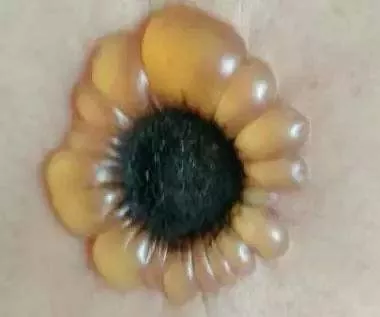
② Non-Scar Moxibustion (Non-Suppurative Moxibustion): Before moxibustion, a small amount of petroleum jelly is applied to the treatment area, and then a small ignited moxa cone is placed on the skin. The practitioner should remove the moxa cone with tweezers when a burning sensation is felt, replacing it with another cone until the skin shows redness without blistering.
This method is mainly used for treating deficiency-cold conditions, is easier to accept, and is more commonly used.
(2) Indirect Moxibustion (Moxibustion with Intermediaries): Indirect moxibustion involves placing certain items (intermediaries) between the moxa cone and the skin before performing moxibustion. Depending on the intermediary used, the following common methods are available.
① Ginger Moxibustion: Fresh ginger is sliced into approximately 0.3 cm thick pieces, with several holes poked in the center, placed on the treatment area, and an ignited moxa cone is placed on top of the ginger slice for moxibustion. When the moxa cone burns out, it is replaced with another cone, aiming for the skin to show redness without blistering.
This method disperses cold and alleviates pain, warms the stomach, and stops vomiting, mainly used for treating wind-cold bi pain, vomiting, and abdominal pain caused by cold.
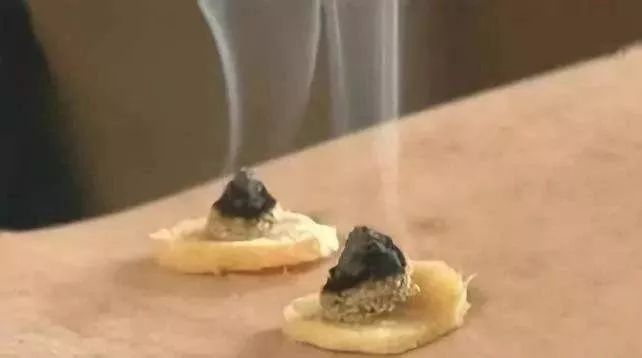
② Garlic Moxibustion: Fresh garlic is crushed into a paste, made into a cake about 0.3 cm thick, or thick slices of single garlic are placed on the acupoint skin, with other operations similar to ginger moxibustion.
This method clears heat, detoxifies, kills parasites, and alleviates itching, mainly used for treating carbuncles and swellings.
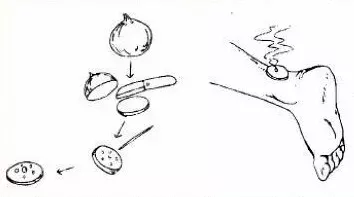
③ Salt Moxibustion: Dry salt is placed on the navel (or a thin slice of ginger can be placed on the salt to prevent the salt from exploding when heated), and then a large moxa cone is placed on top for moxibustion.
This method revives yang and rescues from collapse, mainly used for treating acute vomiting, diarrhea, abdominal pain, and collapse.
④ Fuzi Cake Moxibustion: Fuzi is ground into powder, mixed with alcohol to form a cake the size of a coin, with several holes poked in the center, placed on the treatment area, and then an ignited moxa cone is placed on top for moxibustion.
This method warms the kidneys and tonifies yang, mainly used for treating impotence, premature ejaculation, and chronic non-healing sores caused by kidney yang deficiency.
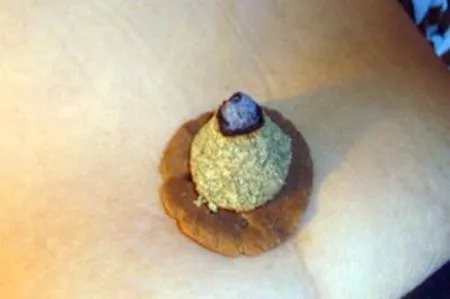
2. Moxibustion with Moxa Sticks
Moxibustion with moxa sticks involves using moxa fluff made into sticks for treatment. Moxa sticks are made by wrapping moxa fluff in cotton paper or mulberry paper into long strips, with those not containing medicinal powders referred to as pure moxa sticks, and those mixed with certain herbal powders referred to as medicinal moxa sticks. Currently, smokeless moxa sticks are also available on the market. Regardless of the type of moxa stick used, the methods of moxibustion with moxa sticks mainly include the following three types.
(1) Gentle Moxibustion: During moxibustion, one end of the moxa stick is ignited and held about 2-3 cm away from the acupoint or treatment area to warm it, ensuring the patient feels warmth without burning. Generally, each area is treated for about 10 minutes until the skin shows redness.
This method warms the meridians and disperses cold, mainly used for treating wind-cold bi pain.
(2) Rotating Moxibustion: During moxibustion, the ignited end of the moxa stick is kept at a certain distance from the skin, but the position of the moxa stick is not fixed; it is moved in a rotating manner during treatment.
This method has a large treatment area and is mainly used for treating larger areas of rheumatic pain, soft tissue injuries, and skin diseases.
(3) Pecking Moxibustion: During moxibustion, the ignited end of the moxa stick is kept at a certain distance from the treatment area, and then it is moved up and down like a bird pecking.
This method is mainly used for treating acute diseases.
3. Warm Needle Moxibustion
Warm needle moxibustion is a treatment method that combines acupuncture and moxibustion. During use, the needle is first inserted into the acupoint, and after obtaining qi, pure moxa fluff is pinched onto the needle tip, or a piece of moxa stick about 2 cm long is directly inserted onto the needle tip, which is then ignited for moxibustion. After the moxa fluff or moxa stick burns out, the ashes are removed, and the needle is taken out.
This method is suitable for conditions that require needle retention and are also suitable for moxibustion.
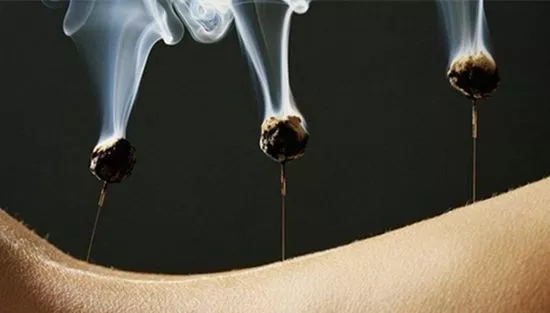
4. Warm Moxibustion Devices
Warm moxibustion devices are specialized tools used for moxibustion therapy. When using a warm moxibustion device, moxa fluff is first placed inside the device and ignited, and then the device is moved back and forth over the acupoint or treatment area until the area turns red. Due to the variety of warm moxibustion devices, it is impossible to introduce them all; here we will only discuss two commonly used types.
(1) Warm Moxibustion Box: The warm moxibustion box is a commonly seen rectangular moxibustion device available in three sizes: large (20 cm × 14 cm × 8 cm), medium (15 cm × 11 cm × 8 cm), and small (11 cm × 9 cm × 8 cm). During moxibustion, the box is placed in the center of the treatment area, an ignited moxa stick is placed on the iron mesh, and the lid is closed to perform moxibustion. Each session lasts 15-30 minutes, and multiple acupoints can be treated at once.
This method is often used for acupoints on the waist, back, and abdomen, commonly used to treat stomach pain, gastric ptosis, diarrhea, coronary heart disease, urinary retention, acute mastitis, cervical spondylosis, sciatica, and stiff neck.
(2) Warm Moxibustion Tube: Common warm moxibustion tubes come in cylindrical and conical shapes, with the cylindrical type suitable for larger treatment areas and the conical type used for small area point moxibustion. The bottom of the warm moxibustion tube has dozens of small holes, with a small tube inside that can hold moxa fluff. During treatment, the moxa fluff is ignited, and the tube is rolled or held stationary over the treatment area for moxibustion. Generally, moxibustion lasts 15-30 minutes.
This method is widely used, mainly for treating wind-cold-damp bi pain, abdominal pain, diarrhea, abdominal distension, and atrophy syndrome.
Currently, commonly used products include single-hole and multi-hole wooden moxibustion boxes, as shown in the image below:
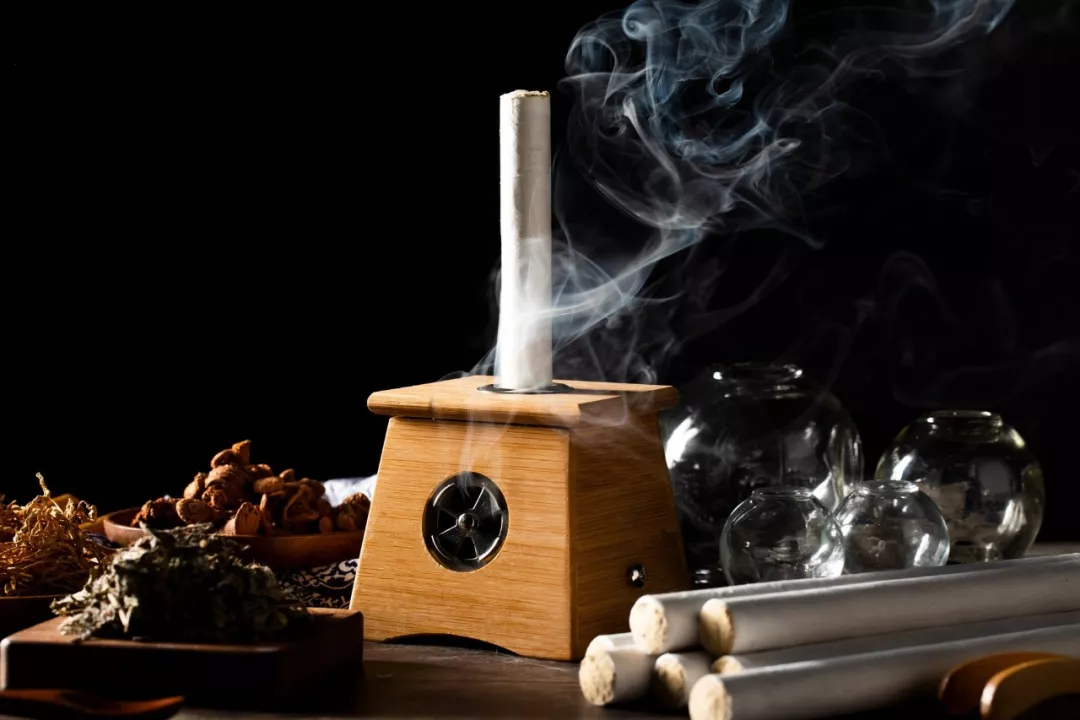
There are also portable moxibustion devices,
as well as moxibustion cups, warm moxibustion sticks, sitting moxibustion devices, warm moxibustion beds, foot moxibustion devices, and eye moxibustion racks among many other warm moxibustion products. The emergence of these products is to facilitate moxibustion, and everyone can choose the products that suit their needs.
Moxibustion Techniques
1. Mastering the “Quantity” of Moxibustion
(1) “Zhuang”: In ancient times, the counting unit for moxibustion was called “zhuang”, meaning that each time a moxa cone is burned, it is referred to as “one zhuang”. Generally, the larger the moxa cone, the greater the stimulation; the more zhuang used, the greater the stimulation. Typically, each acupoint is treated with 3-7 zhuang.
(2) Distance of Moxibustion: For pure moxa stick moxibustion, the distance from the skin is generally 2-3 cm, ensuring no burning sensation occurs. Generally, the greater the distance, the smaller the stimulation.
(3) Duration of Moxibustion: The duration is 5-10 minutes. Generally, the longer the duration, the greater the stimulation.
2. The Order of Moxibustion is Important
Generally, the upper part is treated first, followed by the lower part; the yang areas are treated first, followed by the yin areas; the number of zhuang starts small and increases, and the size of moxa cones starts small and increases. However, in special circumstances, it is not necessary to be overly strict and can be adjusted as needed.
3. The Key to Moxibustion is to Achieve Qi
Research shows: The sensation of transmission is a manifestation of the movement of qi in the meridians, indicating that the body’s endogenous regulatory function has been activated. The efficacy of moxibustion is closely related to the degree of sensation of transmission; the more pronounced the sensation, the better the effect. Using methods to stimulate sensation and promote qi to the affected area can yield unexpected results in moxibustion treatment and disease prevention.
4. Selecting Acupoints Accurately, Ensuring Sufficient Heat
When selecting acupoints for moxibustion, it should be precise, with no more than two or three acupoints. Modern acupuncture experts advocate: “Select acupoints accurately, use fewer needles, and do not use too many acupoints for moxibustion, ensuring sufficient heat and even qi.”
5. Moxibustion is Most Beneficial During Seasonal Changes
During the transition from spring to summer and summer to autumn, moxibustion is beneficial. At this time, the meridians open and close, and the flow of qi and blood circulates. Timely moxibustion with the heat of moxa can assist in the mutual generation of yin and yang, invigorating qi and blood, making treatment and prevention of diseases more effective.
6. Contraindications for Moxibustion
(1) Scar moxibustion should not be used on the face, anterior chest, major blood vessels, and joints.
(2) Caution should be exercised when moxibustion on facial acupoints to avoid burns.
(3) Caution should be exercised during pregnancy and menstruation.
(4) Generally, patients with exogenous heat diseases, yin deficiency with internal heat, insufficient yin fluids, and excessive pathogenic heat should not undergo moxibustion.
(5) Moxibustion is prohibited when the patient is overly fatigued, overfull, overly hungry, extremely thirsty, extremely frightened, or extremely angry.
(6) Patients with heart disease, hypertension, severe qi and blood deficiency, diabetes, and malignant tumors should seek medical advice for point selection and moxibustion under the guidance of a physician.
7. Post-Moxibustion Care
After moxibustion, if the local skin appears slightly red and hot, this is a normal phenomenon and requires no treatment. If blisters appear due to excessive moxibustion or prolonged duration, as long as they are not broken, they can be left to absorb naturally. If the blisters are large, they can be pricked with a sterilized needle to release the fluid, or a syringe can be used to extract the fluid, followed by applying gentian violet and covering with gauze.
If using scar moxibustion, during the suppuration period of the moxibustion sore, it is important to rest appropriately, enhance nutrition, maintain local cleanliness, and use dressings to protect the sore from contamination, allowing it to heal naturally. If not handled properly, if the pus is yellow-green or there is bleeding, anti-inflammatory ointment or Yuhong ointment can be applied.
8. Special Attention to Fire Safety After Moxibustion
After using moxa cones or sticks, ensure they are completely extinguished to prevent re-ignition. Moxa is highly flammable, so it should be extinguished and stored separately in a sealed glass container, with fire safety being a priority.
-END-
Copyright Statement:
This public account shares articles and videos, and the copyright belongs to the relevant rights holders. If there is any improper use, please feel free to contact us. Articles and videos are for learning and communication purposes only, and should not be used for self-medication.
